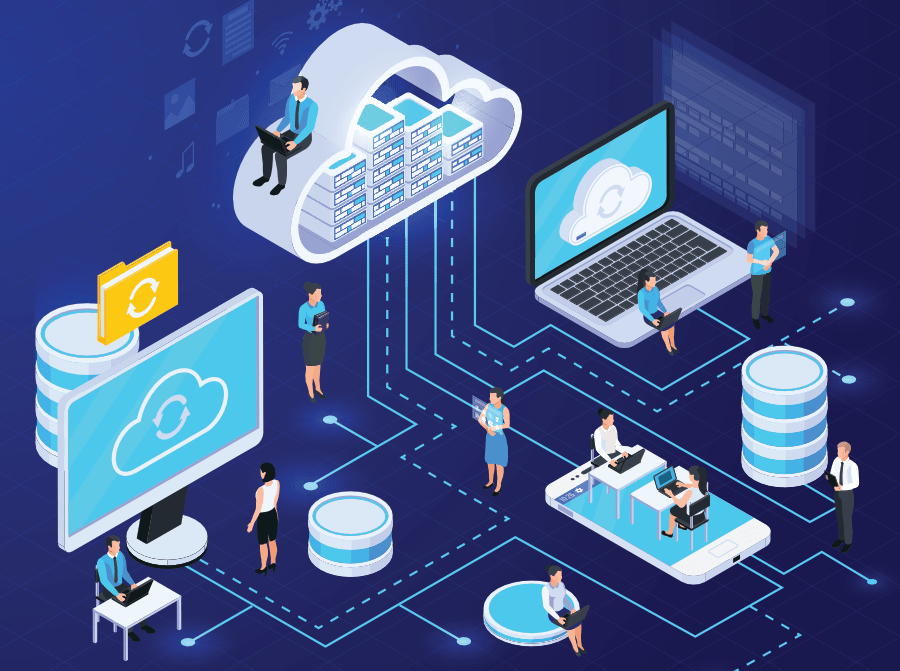What is Cloud Computing ?
Cloud computing refers to any kind of hosted service delivered over the internet. These services often include servers, databases, software, networks, analytics and other computing functions that can be operated through the cloud.
Files and programs stored in the cloud can be accessed anywhere by users on the service, eliminating the need to always be near physical hardware. In the past, for example, user-created documents and spreadsheets had to be saved to a physical hard drive, USB drive or disk. Without some kind of hardware component, the files were completely inaccessible outside the computer they originated on. Thanks to the cloud, few people worry anymore about fried hard drives or lost or corrupted USB drives. Cloud computing makes the documents available everywhere because the data actually lives on a network of hosted servers that transmit data over the internet.
Cloud computing refers to any kind of hosted service delivered over the internet. These services often include servers, databases, software, networks, analytics and other computing functions that can be operated through the cloud.
Files and programs stored in the cloud can be accessed anywhere by users on the service, eliminating the need to always be near physical hardware. In the past, for example, user-created documents and spreadsheets had to be saved to a physical hard drive, USB drive or disk. Without some kind of hardware component, the files were completely inaccessible outside the computer they originated on. Thanks to the cloud, few people worry anymore about fried hard drives or lost or corrupted USB drives. Cloud computing makes the documents available everywhere because the data actually lives on a network of hosted servers that transmit data over the internet.
How does it work ?
The cloud is basically a decentralized place to share information through satellite networks. Every cloud application has a host, and the hosting company is responsible for maintaining the massive data centers that provide the security, storage capacity and computing power needed to maintain all of the information users send to the cloud.
The most prominent companies hosting the cloud are major players like Amazon (Amazon Web Services), Microsoft (Azure), Apple (iCloud) and Google (Google Drive), but there's also a plethora of other players, large and small. These hosting companies can sell the rights to use their clouds and store data on their networks, while also offering the end user an ecosystem that can communicate between devices and programs (e.g., download a song on your laptop and it's instantly synced to the iTunes software on your iPhone).

Generally cloud computing follows three delivery models:
Public: This is the most common and all of the players mentioned above (Amazon, Microsoft, Apple & Google) run public clouds accessible anywhere with login credentials and the right web app.
Private: This model offers the same kind of flexibility as the public cloud, but with the infrastructure needs (hosting, data storage, IT staff, etc.) provided by the companies or users of the service. Additionally, the restricted access and hands-on management of hosting gives the private model an extra layer of security.
Hybrid: Hybrid cloud computing is a combination of the public and private models. The two cloud types are linked over the internet and can share resources when needed (e.g., if the private cloud reaches storage capacity or becomes corrupted, the public cloud can step in and save the day).
Using the Internet, cloud storage works as a repository of all information, applications, and computing resources. This provides access to any device using the Internet. It could be a laptop, a smartphone, or a tablet. As long as there is Internet access, the data uploaded into the cloud computing system will be available. These data can be altered, downloaded and transferred. The accessibility and mobility that cloud storage provides can help us understand cloud computing, what is it and how does it work.
Since access to the cloud is possible as long as there is the Internet, cloud storage allows work collaboration. The simultaneous access of one data makes it easier for several users to incorporate ideas and work together despite the distance. Thus, cloud storage made remote work environment possible. Understanding how storage made cloud functional for data accessibility helps us understand cloud computing, what is it and how does it work.
Architecture of Cloud Computing
For cloud computing to work, three major components have to be present; front end, back end and network. Together these components form the cloud computing architecture. Below is a brief description of each of these components.
Front-end: This refers to the client’s computer or mobile device and the application required to access the cloud computing system. In most cases, the application is a web browser although other systems may require special applications.
Back-end: This refers to the computer infrastructure owned by the cloud provider such as computers, servers, operating systems and storage devices. All the data stored in the cloud is usually stored on the storage devices while software applications run on the cloud are run on the computers. Each software application will also have a dedicated server while a central server will be used to monitor traffic and client demands and ensure everything runs smoothly as required.
Network: This is the key component because it allows the connection of the above two components via the internet.
How different is it from cloud storage:
Cloud storage involves stashing data on hardware in a remote physical location, which can be accessed from any device via the internet. Clients send files to a data server maintained by a cloud provider instead of (or as well as) storing it on their own hard drives. Dropbox, which lets users store and share files, is a good example. Cloud storage systems generally encompass hundreds of data servers linked together by a master control server, but the simplest system might involve just one.
Cloud computing also involves clients connecting to remote computing infrastructure via a network, but this time that infrastructure includes shared processing power, software and other resources. This frees users from having to constantly update and maintain their software and systems, while at the same time allowing them to harness the processing power of a vast network. Familiar everyday services powered by cloud computing include social networks like Facebook, webmail clients like Gmail, and online banking apps.
Types of Cloud Computing:
Public Cloud: is a type of cloud hosting that easily allows the accessibility of systems & its services to its clients/users. Some examples of companies that provide public cloud facilities are IBM, Google, Amazon, Microsoft, etc. This cloud service is open for use. This type of cloud computing is a true specimen of cloud hosting, where the service providers render services to various clients. From the technical point of view, there is the least difference between private clouds and public clouds along with the structural design. Only the security level depends based on the service providers and the type of cloud clients use. The public cloud is better suited for business purposes for managing the load. This type of cloud is economical due to the decrease in capital overheads.
Private Cloud: is also termed as 'Internal Cloud', which allows the accessibility of systems and services within a specific boundary or organization. The cloud platform is implemented in a cloud-based secure environment guarded by advanced firewalls under the surveillance of the IT department that belongs to a particular organization. Private clouds permit only authorized users, providing the organizations greater control over data and its security. Business organizations that have dynamic, critical, secured, management demand-based requirements should adopt Private cloud.
Hybrid Cloud :is another cloud computing type, which is integrated, i.e., it can be a combination of two or more cloud servers, i.e., private, public, or community combined as one architecture, but remain individual entities. Non-critical tasks such as development and test workloads can be done using the public cloud. In contrast, critical tasks that are sensitive such as organization data handling, are done using a private cloud. Benefits of both deployment models, as well as a community deployment model, are possible in a hybrid cloud hosting. It can cross isolation and overcome boundaries by the provider; hence, it cannot be categorized into any of the three deployments - public, private, or community cloud.
Community Cloud:is another type of cloud computing in which the cloud setup is shared manually among different organizations that belong to the same community or area. An example of such a community is where organizations/firms are there, along with the financial institutions/banks. A multi-tenant setup developed using cloud among different organizations that belong to a particular community or group having similar computing concerns.
Benefits of Using Cloud Computing:
The potential uses of cloud computing are only beginning to be grasped. Visions are being built on as the vast possibilities of cloud computing are realized. On both individual and corporate level, cloud computing is likely to change the way we operate.
In Businesses: The cloud has the potential to transform operations, as well as cut costs. Offices running computer networks would no longer have to deal with software installation for each computer, as well as licenses. This alleviates a tremendous IT load. Uses of the cloud include data storage, offering remote access to any work related data.
Its Flexibility: One of the other most obvious uses of cloud computing is the mobility that it brings, both to the recreational user, as well as to the corporate and business user. Many of us are already familiar with some cloud computing services, like Google Docs, or even email services. With these apps we can access documents or mail that is not stored on our PCs, but is available to use because it is stored on a cloud, or remote location.
Its Cost-effectiveness: It is possible to buy only the cloud services you need and have the option to scale up later when necessary, such as during seasonal peaks. This means you don’t have to make huge investments in physical equipment that need maintenance or become obsolete.
Its Backup and disaster recovery: Cloud environments offer extensive ways to easily set up backup and disaster recovery which benefit from the user not needing to purchase new infrastructure. You can make your data redundant across several geographic areas, and you can leverage different speed and cost options for varying levels of backups to customize your disaster recovery plans.

/cloud-computing-502462262-5ac1130e119fa800371ba0a8.jpg)


Comments
Post a Comment